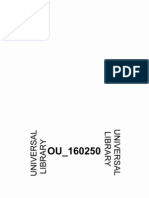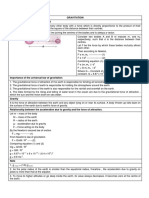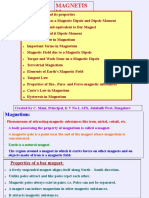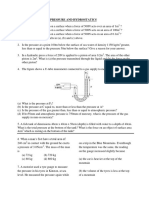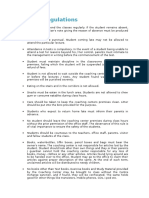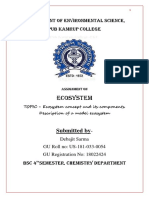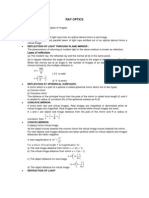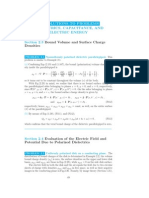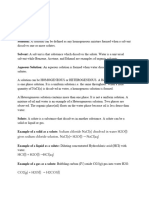14thermal Expansion of Materials - 227-249
14thermal Expansion of Materials - 227-249
Uploaded by
KAMAL KANT KUSHWAHACopyright:
Available Formats
14thermal Expansion of Materials - 227-249
14thermal Expansion of Materials - 227-249
Uploaded by
KAMAL KANT KUSHWAHAOriginal Description:
Original Title
Copyright
Available Formats
Share this document
Did you find this document useful?
Is this content inappropriate?
Copyright:
Available Formats
14thermal Expansion of Materials - 227-249
14thermal Expansion of Materials - 227-249
Uploaded by
KAMAL KANT KUSHWAHACopyright:
Available Formats
THERMAL EXPANSION OF MATERIALS
EXPANSION OF SOLIDS
Synopsis : TEMPERATURE
1.
The invention of thermometer and development of the concept of temperature mark the beginnings of
the science of thermodynamics.
2.
The temperature of a body is a state which determines the direction of flow of heat or the degree of
hotness of a body.
3.
Heat is the cause and temperature is the effect.
4.
A body at a higher temperature need not necessarily contain more heat.
5.
Two bodies at the same temperature may contain different amounts of heat.
6.
Two bodies containing the same amount of heat may be at different temperatures.
7.
The direction of flow of heat from a body does not depend on its heat content but depends on its
temperature.
8.
In principle, any system whose properties change the temperature can be used as a thermometer.
9.
There are four scales of temperature. They are Celsius scale, Fahrenheit scale, Reaumer scale and
Kelvin (or Absolute or thermodynamic temperature) scale.
10. The most fundamental scale of temperature called Kelvin scale is based on the laws of thermodynamics.
11. The melting point of ice at standard atmospheric pressure is taken as the lower fixed point.
12. The boiling point of water at standard pressure is taken as the upper fixed point. The upper fixed point is
determined by using Hypsometer.
13. The distance between the lower and upper fixed points is divided into definite equal divisions.
14. Different scales of temperature.
15. The reading on one scale can be readily converted into corresponding one or the other by the relation
K 273
C
F 32
R
=
=
=
100
100
180
80
16. If in a certain arbitrary scale of temperature, p is the lower fixed point and q is the upper fixed point,
any temperature x in this scale can be converted to Celsius or Fahrenheit scale by using the formula
x p F 32
C
=
=
100 q p
180
17. The differences of temperature on different scales can be converted using the formula
K
C
F
R
=
=
=
100 100 180 80
18. Different types of thermometers and their ranges :
Clinical thermometer
95F to 110F
Mercury t4hermometer
38C to 350C
Alcohol thermometer
110C to 78C
Hydrogen gas thermometer
260C to 1600C
Platinum resistance thermometer 200C to 1200C
Pyrometer very high temperatures
19. Advantages of mercury as a thermometric fluid.
i) Mercury remains as a liquid over a wide range of temperature
ii) Pure mercury can be readily and easily obtained.
iii) Its vapour pressure at ordinary temperature is negligible.
1
Thermal Expansion of materials
iv) It has high conductivity and low thermal capacity. So it quickly attains the temperature of the body by
taking a negligibly small quantity of heat.
v) It does not wet glass and is opaque.
20. Of all the thermometers, gas thermometers are more
sensitive because of their high volume expansion. They
100oC
212oF
80oR
373.15 K
have the same scale for all gases.
21. Using
constant
volume
hydrogen
thermometer,
temperatures ranging from 200C to 1100C can be
0C
32 F
0R
273.15 K
measured. It is generally used to calibrate other
thermometers.
22. To
have
more
surface
contact
with
heat,
the
Celsius
(C)
Fahrenheit
(F)
Reaumer
(R)
Kelvin
(K)
thermometric bulb will be in the shape of a cylinder.
23. To determine the maximum and minimum temperatures attained during a day at a place, Sixs maximum
and minimum thermometer is used.
24. If X is any thermometric property such as pressure or volume or resistance which has values at 0, 100
X t X0
100.
and t on any scale as X0, X100 and Xt, then t =
X100 X 0
25. Temperatures on the Celsius scale denoted by the symbol C (read degrees Celsius). Temperature
changes and temperature differences on the Celsius scale are expressed in C (read Celsius degrees).
For eg: 20C is a temperature and 20 C is a temperature difference. In general, all substances whether
they are in the form of solids, liquids or gases expand on heating except water between 0C and 4C
and some aqueous solutions. This is known as thermal expansion.
EXPANSION OF SOLIDS :
27. A solid can be considered as periodic arrangement of atoms in the form of lattice.
28. At any particular temperature, the atoms are in a specific state of vibration about a
fixed point called as equilibrium position in the lattice.
29. As the temperature increases, the amplitude of vibration of the atoms increases.
30. If the lattice vibrations are purely harmonic the potential energy curve is a symmetric
Interatomic Potential Energy
26. Solids expand on heating due to increased atomic spacing.
Interatomic distance
O
ro
parabola and there is not thermal expansion.
its position and thermal expansion is observed.
32. Coefficient of linear expansion () : The ratio of increase in length per one degree
rise in temperature to its original length is called coefficient of linear expansion.
l l
= 2 1
l1( t 2 t 1 )
Unit of is C o
or K1
33. The change in length is calculated using L=L t
Interatomic Potential Energy
31. If the lattice vibrations are anharmonic, the potential energy of an oscillator is an asymmetric function of
Interatomic distance
O
ro
Thermal Expansion of materials
34. Coefficient of area or superficial expansion () : The increase in area per unit area per one degree rise
in temperature is called coefficient of areal expansion.
a 2 a1
=
a1( t 2 t 1 )
Unit of is C o
or K1
35. The change in area is calculated using formula a=a t.
36. The coefficient of volume or cubical expansion () is the increase in volume per unit volume per degree
rise in temperature.
V2 V1
=
V1( t 2 t 1 )
Unit of is C o
or K1
37. The change in volume is calculated using formula V=V t.
38. For all isotropic substances (solids which expand in the same ratio in all directions) : : = 1:2:3 or
=3; =2; =+.
39. If x, y and z represent the coefficients of linear expansion for an isotropic solids (solids which expand
differently in different directions) in x, y and z directions respectively, then =x+y+z and the average
x + y + z
.
coefficient of linear expansion =
3
40. The numerical value of coefficient of linear expansion of a solid depends on the nature of the material
and the scale of temperature used.
41. The numerical value of coefficient of linear expansion of a solid is independent of physical dimensions of
the body and also on the unit of length chosen.
42. The increase in length or linear expansion of a rod depends on nature of material, initial length of rod
and rise of temperature.
43. The numerical value of or or in the units of per C is 9/5 times its numerical value in the units of per
F.
5
44. per F= . per C.
9
5
45. per R= . per C.
4
46. Variation of density with temperature : The density of a solid decreases with increase of temperature.
do
or d t d o (1 t ) where do is density at 0C.
dt =
1+ t
47. If R1 and R2 are the radii of a disc or a plate at t1C and t2C respectively then R2=R1(1+(t2t1)).
48. A metal scale is calibrated at a particular temperature does not give the correct measurement at any
other temperature.
a) When scale expands correction to be made l=L t, correct reading=L+l
b) When scale contracts correction to be made l=L t, correct reading=Ll. L=measured value.
c) Lmeasured=Ltrue[1(t)]
49. When a metal rod is heated or cooled and is not allowed to expand or contract thermal stress is
developed.
3
Thermal Expansion of materials
Thermal force F=YA (t2t1)
Thermal force is independent of length of rod.
Thermal stress =Y (t2t1)
Y=Youngs modulus
=coefficient of linear expansion
t2t1=difference of temperature
A=area of cross-section of the metal rod.
For same thermal stress in two different rods heated through the same rise in temperature, Y11=Y22.
50. Barometer with brass scale :
Relation between faulty and actual barometric height is given by h2=h1[1+(sYHg)(t2t1)]
h1=height of barometer at t1C where the scale is marked
h2=height of barometer at t2C where the measurement is made
Hg=real coefficient of expansion of mercury
s=coefficient of linear expansion of scale
51. Pendulum clocks lose or gain time as the length increases or decreases respectively.
T t
.
=
The fractional change=
T
2
t
x86400 seconds.
The loss or gain per day=
2
52. The condition required for two rods of different materials to have the difference between the lengths
always constant is L11=L22.
53. A hole in a metal plate expands on heating just like a solid plate of the same size.
54. A cavity of a solid object expands on heating just like a solid object of the same volume.
55. If a hollow pipe and a solid rod of same dimensions made of same material are heated to the same rise
in temperature, both expand equally.
56. If a thin rod and a thick rod of same length and material are heated to same rise in temperature, both
expand equally.
57. If a thin rod and a thick rod of same length and material are heated by equal quantities of heat, thin rod
expands more than thick rod.
58. A rectangular metal plate contains a circular hole. If it is heated, the size of the hole increases and the
shape of the hole remains circular.
59. A metal plate contains two holes at a certain distance apart from each other. If the plate is heated, the
distance between the centers of the holes increases.
60. The change in the volume of a body, when its temperature is raised, does not depend on the cavities
inside the body.
Applications of linear expansion :
61. Platinum (or monel) is used to seal inside glass because both have nearly equal coefficients of linear
expansion.
62. Iron or steel is used for reinforcement in concrete because both have nearly equal coefficients of
expansion.
4
Thermal Expansion of materials
63. Pyrex glass has low . Hence combustion tubes and test tubes for hating purpose are made out of it.
64. Invar steel (steel+nickel) has very low . So it is used in making pendulum clocks, balancing wheels and
measuring tapes. (Composition of invar steel is 64% steel and 36% nickel).
65. Metal pipes that carry steam are provided with bends to allow for expansion.
66. Telephone wires held tightly between the poles snap in winter due to induced tensile stress as a result of
prevented contraction.
67. Thick glass tumbler cracks when hot liquid is poured into it because of unequal expansion.
68. Hot chimney cracks when a drop of water falls on it because of unequal contraction.
69. A brass disc snuggly fits in a hole in a steel plate. To loosen the disc from the hole, the system should
be cooled.
70. To remove a tight metal cap of a glass bottle, it should be warmed.
71. While laying railway tracks, small gaps are left between adjacent rails to allow for free expansion without
affecting the track during summer. Gap to be left (l)=lt=expansion of each rail.
72. Concrete roads are laid in sections and expansion channels are provided between them.
73. Thermostat is a device which maintains a steady temperature.
74. Thermostats are used in refrigerators, automatic irons and incubators.
75. Thermostat is a bimetallic strip made of iron and brass. The principle involved is different materials will
have different coefficients of linear expansion.
76. A bimetallic strip is used in dial-type thermometer.
77. If an iron ring with a saw-cut is heated, the width of the gap increases.
78. Barometric scale which expands or contracts measures wrong pressure. On expansion the true
pressure is less than measured pressure.
Ptrue=Pmeasured[1()t]
where =coefficient of cubical expansion of mercury
=coefficient of linear expansion of the material used in making the scale
t=rise of the temperature
79. When a straight bimetallic strip is heated it bends in such a way that the more expansive metal lies on
the outer side. If d is the thickness of the each strip in a bimetallic strip, then the radius of the compound
d
.
strip is given by R=
( 2 1 )t
EXPANSION OF LIQUIDS
20. Liquids expand on heating except water between 0C and 4C.
21. The expansion of liquids is greater than that of solids (about 10 times).
22. Liquids do not possess any definite shape and require a container to hold them. Hence only cubical
expansion is considered.
23. Since heat effects both the liquid and the container the real expansion of a liquid cannot be detected
directly.
24. For liquids there are two types of cubical expansion
i) coefficient of apparent expansion (a)
5
Thermal Expansion of materials
ii) coefficient of real or absolute expansion (r)
25. Coefficient of apparent expansion of a liquid is the ratio of the apparent increase in volume per 1C rise
of temperature to its initial volume.
apparent increase in volume
a =
original volume x rise in temperatur e
The unit of a is C1.
26. Coefficient of real expansion is the ratio between real increase in volume per 1C rise of temperature
and the original volume of the liquid.
real increase in volume
r =
original volume x rise in temperatur e
V2 V1
V1( t 2 t 1 )
r =
The unit of r is C1.
27. r = a + vessel = a+3.
28. If v=+ve and r<v, a=ve, the level decreases continuously when heated.
29. If v=+ve and r=v; a=0, the level will not change when heated.
30. If v=+ve and r>v; a=+ve, the level first falls and then rise when heated.
31. If v=0; r=a, the level will increase continuously when heated.
32. If v=ve, a>r, the level will increase continuously when heated.
33. The real expansion of a liquid does not depend upon the temperature of the container.
34. The apparent expansion of liquid depends on
a) initial volume or liquid, b) rise in temperature
c) nature of liquid and d) nature of container.
35. ap is determined using specific gravity bottle or pyknometer or weight thermometer.
mass expelled
a =
mass remaining x rise of temperatur e
a =
weight of liquid expelled
weight of remaining liquid x rise of temperatur e
a =
W 2 W3
(W3 W1 )( t 2 t 1 )
36. Sinkers method app =
m1 m 2
/o C
m 2 t 2 m1t 1
m1=loss of weight of body in liquid at t1C
m2=loss of weight of body in liquid at t2C
37. To keep the volume of empty space in a vessel (volume vg) constant at all temperatures by pouring
certain amount of a liquid of volume vl, the condition is vll=vgg where l=coefficient of cubical expansion
of liquid and g=coefficient of cubical expansion of vessel.
38. The fraction of the volume of a flask that must be filled with mercury so that the volume of the empty
space left may be the same at all temperatures is 1/7.
39. The density of a liquid usually decreases when heated. If d1 and d2 are the densities of a liquid at 0C
and tC respectively, then
6
Thermal Expansion of materials
dt =
do
;
1+ r t
dt=do(1rt);
Accurate formula Approximate formula
d1 d 2
/o C
r =
d1t 2 d 2 t 1
ANOMALOUS EXPANSION OF WATER :
40. When water at 0C is heated, its volume decreases upto 4C and from 4C its
volume increases with the increase of temperature. This peculiar behaviour of
water is called anomalous expansion of water. Due to the formation of more
number of hydrogen bonds, water has anomalous expansion.
41. As the temperature increases from 0C to 4C, the density increases and as
the temperature further increases the density decreases. Hence water has maximum
density at 4C.
42. Specific volume is the volume occupied by unit mass. It is the reciprocal of
density. As the temperature increases from 0C to 4C, the specific volume
decreases and as the temperature further increases, the specific volume
increases.
43. Hopes apparatus is used to demonstrate that water has maximum density at 4C.
44. Rubber shows anomalous expansion like water.
45. Dilatometer is used to prove anomalous expansion of water.
46. Aquatic animals are surviving in cold countries due to the anomalous expansion of water.
47. During winter, in cold countries, even if the temperature falls far below 0C, the water in the frozen lakes
or seas at the bottom remains at 4C.
48. When water freezes, it expands and consequently water pipes burst in winter.
49. When water at 4C is filled to the brim of a beaker, then it over flows when it is either cooled or heated.
50. A beaker contains water at 4C and a piece of ice is floating on it. When the ice melts completely, the
level of water increases.
51. When a solid is immersed in a liquid (which does not show anomalous expansion) its apparent weight
increases with the increase of temperature.
52. If W is the weight of a sinker in water at 0C and W1 is weight in water at 4C, then W1<<W.
53. As the temperature of water is increased from 0C to 4C, the apparent weight of a body decreases. At
4C the apparent weight is minimum. On further heating the apparent weight increases.
54. Water has positive coefficient of expansion above 4C and negative coefficient below 4C.
55. At 4C the coefficient of expansion of water is zero.
56. A wooden block is floating in water at 0C. When the temperature of water is increased, the volume of
the block below water surface decreases upto 4C and beyond 4C it increases.
57. In a mercury thermometer, the coefficient of apparent expansion of mercury can be determined by
a =
R 2 l
where l=length of the stem, v=initial volume of mercury in the bulb and t=rise in
vt
temperature.
Thermal Expansion of materials
DETERMINATION OF real OF A LIQUID :
58. Specific gravity bottle method real = app + vessel .
59. Dulong Petit method (U-tube method)
h h0 o
h 2 h1
real = t
/ C (or) real =
.
h0 t
h1t 2 h 2 t 1
ht=height of liquid column in limb at tC
h0=height of liquid column in limb at 0C
60. Regnaults apparatus
h 2 h1
real =
/o C
[H (h 2 h1 )t ]
H=height of liquid in wide tubes
h2h1=difference in heights of liquid columns at tC and 0C in U-tube
61. The corrected height of a barometer is given by the relation H=ht[1(r)t] where H=height at 0C;
ht=height at tC; r=coefficient of real expansion of the liquid and =coefficient of linear expansion of the
material of the scale.
EXPANSION OF GASES
1.
Pressure, volume and temperature are the three measurable properties of a gas. Change in one of
these factors results in a change in the other two factors.
2.
Pressure of a gas is measured by manometer Bourden gauge for high pressures and Mcleod gauge for
low pressures. These work on Boyles law.
3.
Volume of a gas is measured by a gas burette or on Eudiometer.
4.
A gas has neither unique shape nor unique volume. The gas completely occupies the vessel in which it
is placed.
Coefficients of expansion of gas :
5.
When a given mass of gas is heated under constant pressure, its volume increases with increase in
temperature.
6.
When a given mass of gas is heated under constant volume its pressure increases with increase in
temperature. Hence gases have two types of coefficients of expansions.
i) volume expansion coefficient
ii) pressure expansion of coefficient
7.
Volume coefficient of a gas () : At constant pressure the ratio of
increase of volume per 1C rise in temperature to its original volume at
0C is called volume coefficient of a gas.
V V0
V2 V1
= t
or =
V0 t
V1t 2 V2 t 1
toC
-273.15oC
Vt=V0(1+t)
The unit of is C1 or K1.
8.
Pressure coefficient of a gas () : At constant volume the ratio of
increase of pressure per 1C rise in temperature to its original pressure at
0C is called pressure coefficient of gas. Unit is C1 or K1.
-273.15 C
tC
Thermal Expansion of materials
=
Pt P0
P0 t
or
P2 P1
P1t 2 P2 t 1
Pt=P0(1+t)
9.
Regnaults apparatus is used to determine the volume coefficient of a gas.
10. Jollys bulb apparatus is used to determine the pressure coefficient of a gas.
11. Volume coefficient and pressure coefficient of a gas are equal and each equal to
1
/ C or 0.0036/C
273
for all gases.
12. P-t graph or V-t graph is straight line intersecting the temperature axis at 273.15C. This temperature is
called absolute zero. (0 K)
13. Absolute zero is the temperature at which the volume of a given mass of a gas at constant pressure or
the pressure of the same gas at constant volume becomes zero.
14. The lowest temperature attainable is 273.15C or 0 K.
15. The scale of temperature on which the zero corresponds to 273C and each degree is equal to the
Celsius degree is called the absolute scale of temperature or thermodynamic scale of temperature.
T K = t+273.15C
There is no negative temperature on Kelvin scale.
16. Boyles law : At constant temperature, the pressure of a given mass of a gas is inversely proportional to
1
or PV = K (n, T are constant) or P1V1 = P2V2. In PV = K, the value of K depends on
its volume. P
V
the mass and temperature of the gas and the system of units.
17. Boyles law can also be defined as follows. At constant temperature, the pressure of a given mass of
gas is directly proportional to its density.
P
P
P
P d or = K or 1 = 2 .
d
d1 d2
18. P-V graph at a constant temperature (isothermal) is a rectangular hyperbola.
19. PV-V graph is a straight line parallel to volume axis.
1
20. P
graph is a straight line passing through the origin.
V
21. Many gases obey Boyles law only at high temperatures and low pressures.
22. When a Quill tube is kept vertical with the open end upwards, the pressure exerted by gas column is
(H+h) where H is atmospheric pressure and h is the length of mercury pellet.
23. When a Quill tube is kept horizontal, the pressure exerted by gas column is equal to atmospheric
pressure.
24. When a Quill tube is kept vertical with the open end downwards, the pressure exerted by the gas column
is (Hh).
Thermal Expansion of materials
25. When a Quill tube is kept inclined to the vertical at an angle and open end is upwards, then the
pressure exerted by gas column is (H+hcos ).
26. Charles law : At constant pressure, the volume of a given mass of gas increases by 1/273th of its
original volume at 0C for every 1C rise in temperature. (or) At constant pressure, the volume of a given
V
= K (at constant P)
mass of gas is directly proportional to the absolute scale of temperature. V T or
T
27. V-T graph is a straight line passing through the origin.
28. V-t (in C) graph is a straight line which when produced meets the temperature axis at 273.15C or 0 K.
29. The pressure of a given mass of gas at constant volume increases by 1/273th of its original pressure
at 0C for every 1C rise in temperature. (or) At constant volume, the pressure of a given mass of gas
is
directly
proportional
to absolute scale
P
Gay Lussacs law . P T or = K (at constant V)
T
of
temperature.
This
is
also
known
as
Gas Equation :
30. Combining Boyles law and Charles law, the resulting expression is an equation of state for ideal gas.
31. For unit mass of a gas (1 gram or 1 kg)
PV=rt is called Gas Equation
PV=mRT (for m grams)
32. r is called gas constant (or) specific gas constant.
33. The value of r depends on nature and mass of the gas.
34. S.I. unit of r is JKg1K1. Dimensional formula for r is LT21.
35. For one mole of a gas PV=RT is called universal (or) ideal (or) perfect gas equation.
36. The value of R is same for all gases irrespective of their nature.
37. If M is gram molecular mass of the gas, then r = R/m.
m
PV =
RT PV = nRT
M
where n = no. of moles of gas.
38. S.I. unit of R is J mole1K1.
Values of R=8.314 Jg mole1K1
R = 8314 J kg mole1K1
R = 0.0821 litre atmosphere mole1K1
R = 8.314x107 ergs mole1K1
R = 1.987 cal mole1K1
Significance of R:
39. The value of R gives the work done by one mole of any gas when it is heated under constant pressure
through one degree Kelvin.
40. The value of R does not depend on the mass of gas or its chemical formula.
10
Thermal Expansion of materials
41. The fact that R is a constant for all gases is consistent with Avagadros hypothesis that equal
volumes of all gases under same conditions of temperature and pressure contain equal number of
molecules.
42. The value of universal gas constant per molecule is 1.38x1023 J mol1K1
R = N0K, where K = Boltzmanns constant,N0 = Avagadros number
43. The gas equation in terms of density
P
=constant. Where d=density of ideal gas.
dT
44. When pressure and volume are constant for given ideal gas.
m
T
1
K m
, m , 1 2
T
T m 2 T1
45. Two vessels of volumes V1 and V2 contain air pressures P1 and P2 respectively. If they are connected
P V + P2 V2
.
by a small tube of negligible volume then the common pressure is P = 1 1
V1 + V2
46. Daltons law of partial pressures : The total pressure of a non-reacting mixture of gases is equal to
the sum of the partial pressures.
Partial pressure=mole fraction x total pressure.
48. Vapour is a gas which can be liquified by the application of pressure alone.
49. Critical temperature (Tc), critical pressure (Pc) and critical volume (Vc) are called critical constants of a
gas.
50. The temperature above which a gas cannot be liquified by mere application of pressure is called critical
temperature.
51. Gases below their critical temperature are called vapours and vapours above their critical temperature
are called gases
11
You might also like
- Mitosis Meiosis NotesDocument7 pagesMitosis Meiosis NotesSophia Cook100% (1)
- Laboratory Exercises in General Chemistry, Semishin, Peace PublishersDocument343 pagesLaboratory Exercises in General Chemistry, Semishin, Peace PublishersRadhakrishnan SreerekhaNo ratings yet
- Electricity and Its Heating and Chemical EffectsDocument7 pagesElectricity and Its Heating and Chemical EffectsManish Kedawat50% (2)
- Thermodynamics PDFDocument122 pagesThermodynamics PDFPrateek Srivastava100% (1)
- Chapter 3 Lecture Notes Transmission Basics KTDocument24 pagesChapter 3 Lecture Notes Transmission Basics KTKealeboga Duece ThoboloNo ratings yet
- IX - InTSO - Worksheet - 1 (Atoms & Molecules)Document3 pagesIX - InTSO - Worksheet - 1 (Atoms & Molecules)arush0156No ratings yet
- Chapter 4 Illumination1Document37 pagesChapter 4 Illumination1GurusumiNo ratings yet
- Bahria Foundation Colleges (North) Centralized Notes of Short Questions (F.B.I.S.E) Physics SSC-IDocument63 pagesBahria Foundation Colleges (North) Centralized Notes of Short Questions (F.B.I.S.E) Physics SSC-IZaheer AhmedNo ratings yet
- Transformer - Electrical MachineDocument35 pagesTransformer - Electrical Machinemenilanjan89nLNo ratings yet
- MesozoicDocument11 pagesMesozoicGelo LibeloNo ratings yet
- WYE (Y) and DELTA ( ) ConversionDocument12 pagesWYE (Y) and DELTA ( ) Conversionvamps sierNo ratings yet
- Class 5 EM Model Question PaperDocument9 pagesClass 5 EM Model Question PaperManjusha67% (3)
- Chapter 1 IntroductionDocument26 pagesChapter 1 IntroductionGeraldine ChanNo ratings yet
- Mushroom Production Juncao Ottilia Final - AGRITEXDocument21 pagesMushroom Production Juncao Ottilia Final - AGRITEXChary Johanne MenesesNo ratings yet
- Haber Process and AmmoniaDocument2 pagesHaber Process and AmmoniaAaron HongNo ratings yet
- Electrical Machines Lab-II ManualDocument41 pagesElectrical Machines Lab-II Manualsuresh270No ratings yet
- 07 Metamorphic RocksDocument17 pages07 Metamorphic Rocksjcasafranca0% (1)
- Gravitation Newton'S Law of GravitationDocument3 pagesGravitation Newton'S Law of Gravitationnot atallNo ratings yet
- Survey On: "Real Time Water Quality Monitoring System Using Iot and Machine Learning"Document3 pagesSurvey On: "Real Time Water Quality Monitoring System Using Iot and Machine Learning"Snehal100% (1)
- PHY Chapter 21 Heat and TemperatureDocument94 pagesPHY Chapter 21 Heat and TemperatureGabo Silvestre0% (1)
- Generator WorkingDocument18 pagesGenerator WorkingchetanpsNo ratings yet
- Introduction To SoundDocument19 pagesIntroduction To SoundTanmai GowdaNo ratings yet
- Rocks Geography Study Material NotesDocument3 pagesRocks Geography Study Material NotesSTEPHEN AOCKIAM MNo ratings yet
- Radiation Heat TransferDocument3 pagesRadiation Heat TransferAnonymous 2BJgxbxJNo ratings yet
- Created by C. Mani, Principal, K V No.1, AFS, Jalahalli West, BangaloreDocument21 pagesCreated by C. Mani, Principal, K V No.1, AFS, Jalahalli West, BangaloreAnaya SajilalNo ratings yet
- Life Cycle of A BeeDocument2 pagesLife Cycle of A BeeDerassiNo ratings yet
- Pressure and Hydraulics WorksheetDocument2 pagesPressure and Hydraulics WorksheetEsther SparksNo ratings yet
- Heat Chapter 1Document23 pagesHeat Chapter 1Kale DireNo ratings yet
- Genetics and Heredity BiologyDocument7 pagesGenetics and Heredity BiologyMUDASIR REHMANNo ratings yet
- Evolution, Merits and Demerits of Five Kingdom SystemDocument3 pagesEvolution, Merits and Demerits of Five Kingdom SystemDr A.K. VermaNo ratings yet
- Vibrations of Two Degree of Freedom SystemsDocument28 pagesVibrations of Two Degree of Freedom SystemsKautilyaChennaNo ratings yet
- CH 2: Fundamentals of Kinematics: - Topic OutlineDocument36 pagesCH 2: Fundamentals of Kinematics: - Topic OutlineJohn FiveNo ratings yet
- Rajkumar Biology Printable Notes Unit 2 by Rajat.21-37Document17 pagesRajkumar Biology Printable Notes Unit 2 by Rajat.21-37Michael Benton100% (1)
- Structure of GametesDocument4 pagesStructure of Gametesapi-481318101No ratings yet
- RulesDocument2 pagesRulesMCHNo ratings yet
- Magnetism Notes FinalDocument29 pagesMagnetism Notes FinalMuryum SalmanNo ratings yet
- Ecosystem: Department of Environmental Science, Pub Kamrup CollegeDocument8 pagesEcosystem: Department of Environmental Science, Pub Kamrup CollegeDebajit SarmaNo ratings yet
- Qu Sheet - GCSE - The Electric Bell - Qu & Answers PDFDocument2 pagesQu Sheet - GCSE - The Electric Bell - Qu & Answers PDFJohn ChiltonNo ratings yet
- Chapter 7 & 8 Chem Study GuideDocument3 pagesChapter 7 & 8 Chem Study GuideseabreezeNo ratings yet
- Solubility CurvesDocument37 pagesSolubility Curvesapi-298247873100% (1)
- Sound: B. Short/Long Answer Questions AnswerDocument6 pagesSound: B. Short/Long Answer Questions AnswerSayantan ChakrabortyNo ratings yet
- 5.2 Properties of Oxygen and Carbon DioxideDocument14 pages5.2 Properties of Oxygen and Carbon DioxideNorlaily ArsadNo ratings yet
- C3. Laws of ThermodynamicsDocument29 pagesC3. Laws of ThermodynamicsLarry MagallanoNo ratings yet
- AGB 121: Principles of Animal Genetics and Population Genetics (2+1)Document299 pagesAGB 121: Principles of Animal Genetics and Population Genetics (2+1)Deep Patel100% (1)
- Catenation PDFDocument2 pagesCatenation PDFAli AyanNo ratings yet
- Ship Safety An Environmental Protection Instruction:: Total Time 120 Min Total Question 50 Uscg First 200 QuestionDocument40 pagesShip Safety An Environmental Protection Instruction:: Total Time 120 Min Total Question 50 Uscg First 200 QuestionSheikh MonirulNo ratings yet
- Ch-2 Electrical Circuit Anlysis-PART 1Document44 pagesCh-2 Electrical Circuit Anlysis-PART 1temesgen adugnaNo ratings yet
- Basic Principles Basic Transformer Parameters and Construction Construction Conclusion BibliographyDocument17 pagesBasic Principles Basic Transformer Parameters and Construction Construction Conclusion BibliographySHANKAR PRINTINGNo ratings yet
- South Sudan Forests Reserve OpportunityDocument26 pagesSouth Sudan Forests Reserve Opportunityugborodo1100% (1)
- Heat Exchangers in Refrigeration - English PDFDocument1 pageHeat Exchangers in Refrigeration - English PDFavramusNo ratings yet
- Chemical Bonding and Mot SynopsisDocument21 pagesChemical Bonding and Mot Synopsispochireddy revathiNo ratings yet
- Solid Mechanics - Unit 1 NotesDocument34 pagesSolid Mechanics - Unit 1 NotesBONI TARUNNo ratings yet
- Class 12 CH 9 Ray & Wave OpticsDocument7 pagesClass 12 CH 9 Ray & Wave OpticsKumar PratikNo ratings yet
- Lebanese International University School of EngineeringDocument12 pagesLebanese International University School of EngineeringHassan RashedNo ratings yet
- States of Matter Power Point 17-18Document31 pagesStates of Matter Power Point 17-18api-403742992No ratings yet
- Analysis of Variance (ANOVA) : Table 1 K Random SamplesDocument5 pagesAnalysis of Variance (ANOVA) : Table 1 K Random SamplesAisha FarooqNo ratings yet
- Chapter-12 Electricity Annexure 1DDocument8 pagesChapter-12 Electricity Annexure 1DSuhani GosainNo ratings yet
- Thermal ExpansionDocument11 pagesThermal ExpansionSneha GoyalNo ratings yet
- Chapter - 11 HeatDocument22 pagesChapter - 11 HeatMuhammad Arif RattarNo ratings yet
- Phy CH 8 Final 9thDocument28 pagesPhy CH 8 Final 9thmastersahb302No ratings yet
- Thermal PhysicsDocument68 pagesThermal PhysicsRahul KumarNo ratings yet
- EllipseDocument104 pagesEllipseKAMAL KANT KUSHWAHA100% (1)
- Understanding Physics For Jee Main and Advanced Mechanics Part 2 PDFDocument100 pagesUnderstanding Physics For Jee Main and Advanced Mechanics Part 2 PDFKAMAL KANT KUSHWAHANo ratings yet
- IIT-09-STS6-Paper2 Qns - PDF Jsessionid DNIPNGLEGLCG (15) .PDF Jsessionid DNIPNGLEGLCGDocument24 pagesIIT-09-STS6-Paper2 Qns - PDF Jsessionid DNIPNGLEGLCG (15) .PDF Jsessionid DNIPNGLEGLCGgrdgerNo ratings yet
- IIT Sts Vii/Mpc/P (Ii) /solns: Paper Ii Solutions Mathematics Physics ChemistryDocument22 pagesIIT Sts Vii/Mpc/P (Ii) /solns: Paper Ii Solutions Mathematics Physics ChemistryKAMAL KANT KUSHWAHANo ratings yet
- CS06 KeysDocument1 pageCS06 KeysKAMAL KANT KUSHWAHANo ratings yet
- Motion of Systems of Particles Class XIDocument14 pagesMotion of Systems of Particles Class XIKAMAL KANT KUSHWAHANo ratings yet
- Chapter 3:vectors Scalars and VectorsDocument7 pagesChapter 3:vectors Scalars and VectorsKAMAL KANT KUSHWAHANo ratings yet
- Chapter 8 Class 11Document6 pagesChapter 8 Class 11KAMAL KANT KUSHWAHANo ratings yet
- Simultaneous Determination of Bupivacaine, Mepivacain, Prilocaine and Ropivacain in Human Serum by Liquid Chromatography-Tandem Mass SpectrometryDocument5 pagesSimultaneous Determination of Bupivacaine, Mepivacain, Prilocaine and Ropivacain in Human Serum by Liquid Chromatography-Tandem Mass SpectrometryrusspickfordNo ratings yet
- Sandvik - Welding Handbook PDFDocument365 pagesSandvik - Welding Handbook PDFRoberto100% (2)
- 7 Transformer Protection DevicesDocument16 pages7 Transformer Protection Devicesyalewlet tarekeggnNo ratings yet
- Week 13,14 Treatment of WaterDocument55 pagesWeek 13,14 Treatment of WaterWarid BangashNo ratings yet
- Cargo Work: (IMO MODEL COURSE 7.03 REF. NO 2.2.1.)Document12 pagesCargo Work: (IMO MODEL COURSE 7.03 REF. NO 2.2.1.)MayankNo ratings yet
- 4.1.1a TestDocument12 pages4.1.1a Testvigneshwarannn0% (1)
- Oxidative Phosphorylation Glycolysis: 2 Phosphates Krebs/citric/TCA Cycle: 1 PhosphateDocument17 pagesOxidative Phosphorylation Glycolysis: 2 Phosphates Krebs/citric/TCA Cycle: 1 PhosphatereeNo ratings yet
- Dielectrics, Capacitance, and Electric Energy Section 2.3: Solutions To ProblemsDocument43 pagesDielectrics, Capacitance, and Electric Energy Section 2.3: Solutions To ProblemsJehrad Crews100% (1)
- RRB Alp Kolkata Prosen SirDocument8 pagesRRB Alp Kolkata Prosen SirBlue Eye'sNo ratings yet
- Henrys ComponentsDocument3 pagesHenrys ComponentsFalom BanderNo ratings yet
- Ch. 3 Lecture Slides For Chenming Hu Book: Modern Semiconductor Devices For ICsDocument40 pagesCh. 3 Lecture Slides For Chenming Hu Book: Modern Semiconductor Devices For ICsChenming Hu100% (1)
- Batangas State University: The National Engineering UniversityDocument4 pagesBatangas State University: The National Engineering UniversityJovie AgcaoiliNo ratings yet
- 160A Lab Manual-Student S2014Document34 pages160A Lab Manual-Student S2014Joel SanchezNo ratings yet
- Lecture 9 Notes, Electromagnetic Theory I: 1. Electrostatic Equations With Ponderable MaterialsDocument9 pagesLecture 9 Notes, Electromagnetic Theory I: 1. Electrostatic Equations With Ponderable MaterialsAkalu AmereNo ratings yet
- S-N DiagramDocument7 pagesS-N DiagrammaheshmbelgaviNo ratings yet
- Half Course Test FiitjeeDocument19 pagesHalf Course Test FiitjeemuraliNo ratings yet
- KYDEX® Sheet Technical Brief 140-C - Ideal Conditions For Forming KYDEX® SheetDocument4 pagesKYDEX® Sheet Technical Brief 140-C - Ideal Conditions For Forming KYDEX® Sheetsimonerusso72No ratings yet
- Pelayanan Resep ApotekDocument37 pagesPelayanan Resep Apotekfairuz syafira rahmahNo ratings yet
- SS2 Chemistry Solubility Week 3Document6 pagesSS2 Chemistry Solubility Week 3kumoyejoyNo ratings yet
- Sights of Celestial ObjectDocument10 pagesSights of Celestial ObjectReetam Bose100% (1)
- 11 - Denture Tablet Blast Off ExemplarDocument5 pages11 - Denture Tablet Blast Off ExemplarHuck KimNo ratings yet
- Kaur 2019Document21 pagesKaur 2019Prakoso AdiNo ratings yet
- The Electromagnetic Universe: Part One: On The Propagation and Dispersion of LightDocument18 pagesThe Electromagnetic Universe: Part One: On The Propagation and Dispersion of LightMircea100% (1)
- Ultro 900 WG SDSDocument6 pagesUltro 900 WG SDSJOHNNYNUTSNo ratings yet
- Plasmonic Lecture 1 - Light Matter and Plsmon Coupling - 25072021Document53 pagesPlasmonic Lecture 1 - Light Matter and Plsmon Coupling - 25072021nbackupgNo ratings yet
- Soil Mechanics ReportDocument74 pagesSoil Mechanics ReportHasan J. AwadNo ratings yet
- Unveiling The Mysteries of Dark Matter EssayDocument1 pageUnveiling The Mysteries of Dark Matter EssayvNo ratings yet
- Abb Kopex Ex DTS A1 Poster 2018 AwDocument1 pageAbb Kopex Ex DTS A1 Poster 2018 Awmohamed abourayaNo ratings yet
- Insects 11 00876Document13 pagesInsects 11 00876nguoidiquaNo ratings yet

